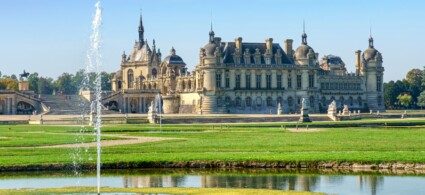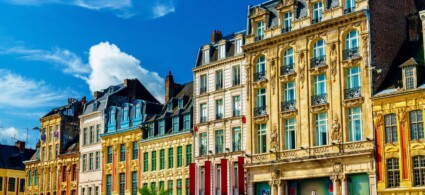

Northern France refers to the area of the former regions of Nord-Pas-de-Calais and Picardie. Today, these two regions are no longer administratively active, as after the reform of the French regions in 2016, they were united into a single region called Haute France.
Haute-France overlooks the English Channel and offers a rich and varied territory, with an ancient historical and cultural heritage, architecture with multiple influences, gathered from the great pages of regional history, museums, attractions and interesting towns. It is believed that the Gothic style was born here.
In this region, cradle of culture and tradition, you will also find a beautiful variety of landscapes, from vast sandy beaches to cliffs overlooking the ocean, from forests to sleepy countryside. Not forgetting its welcoming and convivial atmosphere, its mouth-watering gastronomy and its picturesque towns.
An authentic and welcoming land, the region offers a wide range of unexpected discoveries such as cities rich in history, marvellous castles, surprising museums and wild high cliffs.

The capital of the department, Lille is an extraordinary city to visit in a couple of days. Its cultural panorama and its historical and gastronomic heritage will not leave you indifferent: among the alleys of Old Lille, you will lose yourself in an urban network full of life, showing the various signs of time and the historical vicissitudes it has had to endure, from the Middle Ages to the Hundred Years’ War, passing through the Industrial Revolution.
A pleasant and lively city, it has become a renowned university, cultural and artistic centre: its welcoming and amiable atmosphere will amaze you.

Capital of Picardy and a city of art and history, Amiens has a jewel of Gothic art: the Notre-Dame cathedral, an absolute gravity-defying masterpiece, one of the largest and most beautiful in all of France.
Not far from the cathedral is the medieval district of Saint-Leu, also called the little Venice of the north. This old quarter of tanners, weavers and dyers is truly charming, with its colourful little houses overlooking the canals and numerous terraces full of restaurants and cafés.
Also not to be missed are the UNESCO World Heritage belfry and the Jules Verne Museum.

To discover the port city of Calais, an obligatory passage point to England, you can start by visiting the town hall and its bell tower, listed as a UNESCO World Heritage Site. After a refreshing stop in the Richelieu Park, continue with a visit to the Musée des Beaux-Arts, which houses important works by Renoir.
With a few hours to spare, head to Place d’Armes, stroll along the seafront, climb to the top of the lighthouse and immerse yourself in the past by visiting the International City of Lace and Fashion.

The city of Chantilly is famous for its famous whipped cream and equestrian activities. Indeed, the Chantilly racecourse welcomes 40,000 visitors each year, who come from all over Europe to see the Prix du Jockey Club and the Prix de Diane, 42 days of consecutive races.
Not to be missed is Chantilly Castle, a magnificent historical building, now home to the Condé Museum and the Grandes Écuries.

Gerberoy is considered one of the most beautiful villages in France: here, time seems to stand still and every corner enchants with its picturesque charm.
With less than 100 inhabitants, it is nicknamed the village of a thousand roses. Indeed, the rose is the symbol of this corner of paradise, often portrayed by the painter Le Sidaner, with its 25 varieties of flower gardens.
In the heart of Boulogne-sur-Mer is the Centre national de la mer. Created from the redevelopment of a former casino in the city, Nausicaá has become the largest aquarium in Europe.
With tanks housing almost 1,600 different species, the centre is focused on popularisation, educating its visitors on the importance of marine life and its conservation. Its playful, educational approach makes this place a must-visit in Picardy and the North.
Inaugurated in 2012, the Louvre-Lens museum symbolises the desire for post-industrial reconversion in Haute-France: in fact, it was built in the middle of a 20-hectare park on a disused mining site. A branch of the Parisian museum of the same name, the museum was conceived as a spectacular building capable of catalysing light, designed by the Japanese SANAA studio in collaboration with the American architects Imrey-Culbert.
The Louvre-Lens offers a permanent exhibition divided into three sections, Antiquity, the Middle Ages and the Modern Era, housing pieces from the Louvre’s immense collections: the works change and rotate throughout the year to ensure a constantly evolving exhibition.
In this fabulous stretch of coastline, sky and sea merge together, while the towns bordering the Channel have inspired many artists: Jules Verne, Alfred Manessier, Edgar Degas and Victor Hugo. The Côte d’Opale is one of France’s most beautiful natural sites and stretches 120 km between Dunkirk and Berck-sur-Mer with its sheer chalk cliffs: they are the natural continuation of the Alabaster Coast of Etretat in Normandy. Not to be missed is the magnificent Cap Blanc-Nez, one of the jewels of the coast, full of hiking trails.
Nearby is also the Bay of Somme, which attracts hundreds of thousands of visitors every year. Nature, animal, history or culture enthusiasts come to explore the Crécy forest, white chalk cliffs, marshes and windswept sandy beaches.
In the following map you can see the location of the main places of interest mentioned in this article.

Just a stone’s throw away from Belgium, northern France, and in particular the Nord-Pas-de-Calais area, has become famous for a particularly funny comedy film, Welcome to the Sticks, in which the cultural and social peculiarities of this borderland are showcased.
The film follows the misadventures of a French postmaster from Salon-de-Provence in Provence, Philippe Abrams, who would like to move with his whole family to a place with a better climate and tries hard to obtain a transfer to a seaside resort in the south of France.
After being refused a transfer to Cassis because he had been overtaken in the rankings by a disabled colleague, he pretends to be an invalid and manages to get the coveted transfer in the first instance. But at the first control he clumsily gets caught and to avoid dismissal accepts a temporary transfer to the icy North, to the small town of Bergues, near Dunkirk.
From here it is a succession of hilarious situations and misunderstandings, based on the prejudices and commonplaces that the French are used to thinking about northern regions: polar cold, incomprehensible dialect and unfriendly, ignorant people.
Philippe discovers instead that the climate is not so harsh and above all that the people of the north can be extremely kind and welcoming: he makes new friends and begins to appreciate their customs, becoming very attached to both the places and his new friends. At the same time, however, he had never stopped complaining to his wife Julie, telling lies about the terrible conditions in which he was forced to live, generating anxiety and apprehension in his wife.
The showdown will come when Julie decides to visit him in Bergues: Philippe’s friends will play along and help him organise a play to make the north seem as terrible a place as her husband had always described it. But lies have short legs and even his wife will realise that the north is a pleasant place to live and will join her husband in Bergues.
Three years later, after the period of disciplinary exile is over, Philippe is sad to say goodbye to his friends to go and take up the coveted postmaster’s post on Porquerolles, an island in the South of France.
There was also an Italian remake of the film starring Claudio Bisio and Alessandro Siani called ‘Benvenuti al Sud‘, which played on the differences between Lombardy and Campania.
The Haute-France region can be reached very easily by plane. The most convenient and closest airports are certainly those in the capital: Paris Orly Airport, Paris-Charles de Gaulle Airport and Paris-Beauvais Airport.
From here, you can conveniently rent a car to start your journey to discover the most important places in the region that are difficult to reach by car, such as the cliffs of Cap Gris-Nez or Cap Blanc-Nez.




